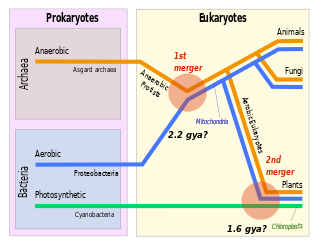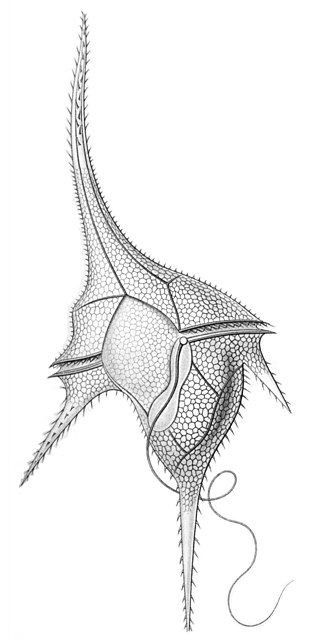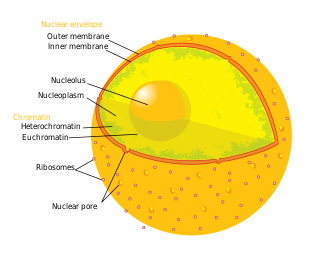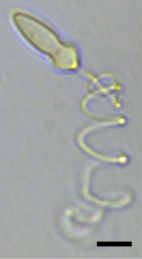
The cell nucleus is a membrane-bound organelle found in eukaryotic cells. Eukaryotic cells usually have a single nucleus, but a few cell types, such as mammalian red blood cells, have no nuclei, and a few others including osteoclasts have many. The main structures making up the nucleus are the nuclear envelope, a double membrane that encloses the entire organelle and isolates its contents from the cellular cytoplasm; and the nuclear matrix, a network within the nucleus that adds mechanical support.
Chromatin is a complex of DNA and protein found in eukaryotic cells. The primary function is to package long DNA molecules into more compact, denser structures. This prevents the strands from becoming tangled and also plays important roles in reinforcing the DNA during cell division, preventing DNA damage, and regulating gene expression and DNA replication. During mitosis and meiosis, chromatin facilitates proper segregation of the chromosomes in anaphase; the characteristic shapes of chromosomes visible during this stage are the result of DNA being coiled into highly condensed chromatin.

In biology, histones are highly basic proteins abundant in lysine and arginine residues that are found in eukaryotic cell nuclei and in most Archaeal phyla. They act as spools around which DNA winds to create structural units called nucleosomes. Nucleosomes in turn are wrapped into 30-nanometer fibers that form tightly packed chromatin. Histones prevent DNA from becoming tangled and protect it from DNA damage. In addition, histones play important roles in gene regulation and DNA replication. Without histones, unwound DNA in chromosomes would be very long. For example, each human cell has about 1.8 meters of DNA if completely stretched out; however, when wound about histones, this length is reduced to about 90 micrometers (0.09 mm) of 30 nm diameter chromatin fibers.

Symbiogenesis is the leading evolutionary theory of the origin of eukaryotic cells from prokaryotic organisms. The theory holds that mitochondria, plastids such as chloroplasts, and possibly other organelles of eukaryotic cells are descended from formerly free-living prokaryotes taken one inside the other in endosymbiosis. Mitochondria appear to be phylogenetically related to Rickettsiales bacteria, while chloroplasts are thought to be related to cyanobacteria.

The dinoflagellates are a monophyletic group of single-celled eukaryotes constituting the phylum Dinoflagellata and are usually considered protists. Dinoflagellates are mostly marine plankton, but they also are common in freshwater habitats. Their populations vary with sea surface temperature, salinity, and depth. Many dinoflagellates are photosynthetic, but a large fraction of these are in fact mixotrophic, combining photosynthesis with ingestion of prey.

In cell biology, the spindle apparatus is the cytoskeletal structure of eukaryotic cells that forms during cell division to separate sister chromatids between daughter cells. It is referred to as the mitotic spindle during mitosis, a process that produces genetically identical daughter cells, or the meiotic spindle during meiosis, a process that produces gametes with half the number of chromosomes of the parent cell.
In cellular biology, a somatic cell, or vegetal cell, is any biological cell forming the body of a multicellular organism other than a gamete, germ cell, gametocyte or undifferentiated stem cell. Somatic cells compose the body of an organism and divide through the process of binary fission and mitotic division.

The nucleoplasm, also known as karyoplasm, is the type of protoplasm that makes up the cell nucleus, the most prominent organelle of the eukaryotic cell. It is enclosed by the nuclear envelope, also known as the nuclear membrane. The nucleoplasm resembles the cytoplasm of a eukaryotic cell in that it is a gel-like substance found within a membrane, although the nucleoplasm only fills out the space in the nucleus and has its own unique functions. The nucleoplasm suspends structures within the nucleus that are not membrane-bound and is responsible for maintaining the shape of the nucleus. The structures suspended in the nucleoplasm include chromosomes, various proteins, nuclear bodies, the nucleolus, nucleoporins, nucleotides, and nuclear speckles.
HMGN proteins are members of the broader class of high mobility group (HMG) chromosomal proteins that are involved in regulation of transcription, replication, recombination, and DNA repair.

Phosphatidylinositol (3,4,5)-trisphosphate (PtdIns(3,4,5)P3), abbreviated PIP3, is the product of the class I phosphoinositide 3-kinases' (PI 3-kinases) phosphorylation of phosphatidylinositol (4,5)-bisphosphate (PIP2). It is a phospholipid that resides on the plasma membrane.

Najash is an extinct genus of basal snake from the Late Cretaceous Candeleros Formation of Patagonia. Like a number of other Cretaceous and living snakes it retained hindlimbs, but Najash is unusual in having well-developed legs that extend outside the rib cage, and a pelvis connected to the spine.

Antigen Kiel 67, also known as Ki-67 or MKI67, is a protein that in humans is encoded by the MKI67 gene.

Myzozoa is a grouping of specific phyla within Alveolata, that either feed through myzocytosis, or were ancestrally capable of feeding through myzocytosis.

Guillardia is a genus of marine biflagellate cryptomonad algae with a plastid obtained through secondary endosymbiosis of a red alga.
Mastadenovirus is a genus of viruses in the family Adenoviridae. Humans and other mammals serve as natural hosts. There are 51 species in this genus. The genus as a whole includes many very common causes of human infection, estimated to be responsible for 2 to 5% of all respiratory infections, as well as gastrointestinal and eye infections. Symptoms are usually mild.

Polykrikos is one of the genera of family Polykrikaceae that includes athecate pseudocolony-forming dinoflagellates. Polykrikos are characterized by a sophisticated ballistic apparatus, named the nematocyst-taeniocyst complex, which allows species to prey on a variety of organisms. Polykrikos have been found to regulate algal blooms as they feed on toxic dinoflagellates. However, there is also some data available on Polykrikos being toxic to fish.
Blastodinium is a diverse genus of dinoflagellates and important parasites of planktonic copepods. They exist in either a parasitic stage, a trophont stage, and a dinospore stage. Although morphologically and functionally diverse, as parasites they live exclusively in the intestinal tract of copeods.

Haplozoon (/hæploʊ’zoʊən/) are unicellular endo-parasites, primarily infecting maldanid polychaetes. They belong to Dinoflagellata but differ from typical dinoflagellates. Most dinoflagellates are free-living and possess two flagella. Instead, Haplozoon belong to a 5% minority of parasitic dinoflagellates that are not free-living. Additionally, the Haplozoon trophont stage is particularly unique due to an apparent lack of flagella. The presence of flagella or remnant structures is the subject of ongoing research.
Dinoflagellate/viral nucleoproteins (DVNPs) are a family of positively-charged, DNA-binding nucleoproteins found exclusively in dinoflagellates and Nucleocytoviricota. It serves to compact DNA in these organisms.
Camilla Sih Mai Pang is a British computational biologist, writer, and autism advocate. In 2020, she was awarded the Royal Society Prize for Science Books for her memoir, Explaining Humans: What Science Can Teach Us about Life, Love and Relationships.













